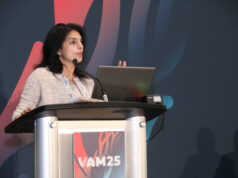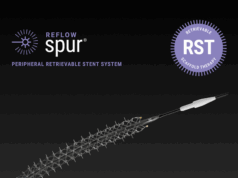
Athanasios Saratzis (University of Leicester, Leicester, UK) speaks to Vascular News about the EVOCC trial, which he hopes will dispel patient and physician “uncertainty” around the best treatment option for severe occlusive aortoiliac disease. This randomised study recently received funding from the UK’s National Institute for Health and Care Research (NIHR), marking the first step in what Saratzis states will be “one of the largest peripheral arterial disease [PAD] trials in the UK over the next few years”.
What is the rationale behind this randomised trial?
This was really a patient-initiated study. In Leicester, a lot of our patients feel that there is uncertainty surrounding treatment decisions for those who have severe aortoiliac disease, with regards to how it is decided whether open surgery or endovascular surgery is better. We realised about two or three years ago that there is actually no literature on this. We do not really know whether the results of open surgery are better compared to endovascular treatment, and we do not really know which endovascular surgery or endovascular treatment is the best one in terms of which stents to use and how you use them. Against this backdrop, we performed a meta-analysis that was a joint project between our centre in Leicester and St Thomas’ Hospital in London, UK. We looked at the few studies that have been published in this domain, and found out that actually modern endovascular techniques are probably as good as open surgery, at least for the first few months. However, there is not much data available on what happens after the first three months, especially with regards to reinterventions or late clinical events. When we applied for funding to the NIHR, it was decided that this was an important project, and here we are.
How would you describe the current landscape of care for severe aortoiliac disease across the UK?
In order to design the study, we sent out a national survey to which 144 interventional radiologists and vascular surgeons replied. We also involved 28 patients nationally who had some form of treatment for this condition in order for us to understand what the treatment landscape is like. About 80% of the surgeons and radiologists who took part in the survey were in agreement that we do not really know whether open surgery is better than modern endovascular treatments in this setting; about 95% felt that we need to do a randomised trial in order to compare modern endovascular treatments and the traditional type of surgery that we have been offering to patients. The patients were all in agreement that they would take part in a study as long as the treatments were safe. Our survey showed that there are still some centres that have got a preference for open surgery and some other centres might have a preference for endovascular surgery, but none of that is actually based on very strong evidence.
How many patients do you hope to enrol and what is the timeline?
This will be a difficult study because of the fact that patients with chronic limb-threatening ischaemia (CLTI) are often frail, which means that it is not very easy to ask them to take part in studies and sometimes decision-making for these patients can be complex. Therefore, I am not expecting that it will be an easy study to complete. In order for us to compare the two treatments in terms of our primary outcome of amputation-free survival, we need to recruit 628 patients. We aim to do this over a period of about 30 months. An internal pilot study, which will start in October 2023, is the first phase of the trial, and that will go on for at least six months. Following that, we will open our main recruitment phase, which will last two years. We are going to follow every patient up for at least two years and for a median of three years. It is our hope that 30 sites (hospitals across the NHS) will take part in the trial. So far, we have been in touch with 35 sites, most of which have confirmed that they would like to participate.
It will take a few years before we know the results of the study because it is a big project. I think the internal pilot will give us a lot of interesting information and then hopefully we will be able to recruit the 600 patients that we need for the main study.
What do you expect from this trial? Do you have an idea of how the results might play out?
Not really! If you asked me a few months ago, I would have said that endovascular treatments are definitely seeing major improvements. However, the BEST-CLI trial report from the USA clearly shows that for CLTI patients with disease below the inguinal ligament, surgery seems to do a bit better. So, I am not sure whether we will see the same signal in patients with aortoiliac disease. I think there is just so much uncertainty, and in fact the BEST-CLI results have confirmed even more the fact that we need to do this trial. I am an endovascular enthusiast, but increasingly I am becoming more and more uncertain as to which treatment is the best one. It is a very grey area, let me put it that way.
On the topic of BEST-CLI, how do you think the results might impact the landscape of vascular trials going forward?
I think BEST-CLI is a turning point in vascular surgery, especially in PAD, because we are now funding more effectiveness trials like this one. We really need the support of all vascular clinicians in order to recruit to those studies efficiently in the years to come. It is borderline unacceptable to offer complex endovascular treatments to patients with vascular diseases and not recruit into big effectiveness trials assessing these treatments. There are clearly many questions that have not been answered, and these are not my questions, they are questions that the patients bring up and impact on their care.














We need to know in advance the n required to recruit.